Frequently Asked Questions
As of July 16, 2020
Where will the new, state-of-the-art Mote Science Education Aquarium (Mote SEA) be located?
It will be located on 12 acres (see circled area) in Nathan Benderson Park, a nexus location for Sarasota and Manatee County, Florida, near I-75.
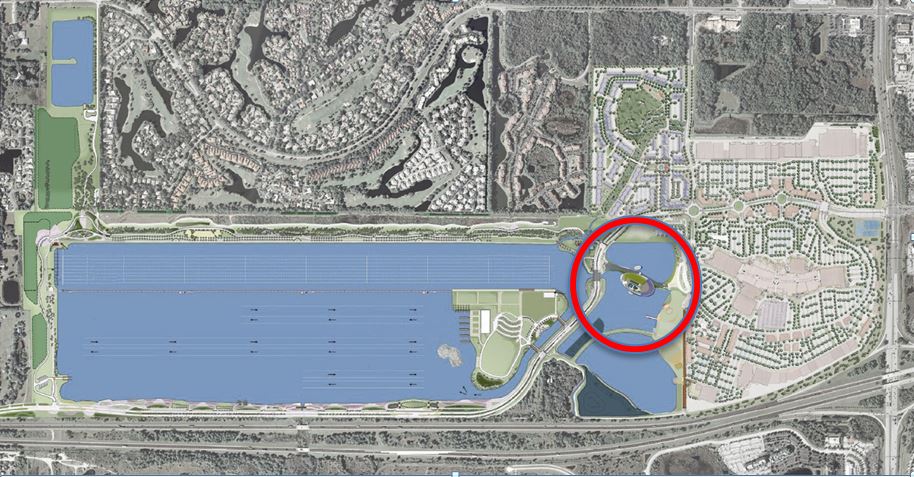
What is the timeline for construction of Mote SEA?
Construction of Mote SEA began in April 2021 and completion is anticipated in the fall/winter of 2024.
What is the status of the facility’s design and planning?
The first phases of schematic design focused on some of the most prominent components of the facility, such as key exhibits and STEM teaching labs, as well as the beginnings of the engineering and site development. In early 2020, after carefully reviewing the schematic designs and renderings of Mote SEA, Mote worked with tvsdesign on further improvements to support the facility’s constructability, functionality and visitor flow. Completion of construction documents is expected by December 2020. For more detailed updates, please view our Mote SEA milestones.
Has Mote secured a land-use agreement with Sarasota County?
In January 2019 the Sarasota County Commission unanimously approved a two-year lease and conveyance agreement on 12 acres in Nathan Benderson Park. Mote began a two-year lease for preconstruction efforts, such as land-use approvals and permits. Once all land-use approvals are complete and Mote has raised necessary funding, construction of Mote SEA will commence. The lease also outlines steps for eventual conveyance of the property to Mote by means of a deed.
What is the cost for Mote SEA?
To realize our vision for the new Mote SEA—enhancing ocean literacy for more people from all walks of life—we are proud to present our fundraising effort Oceans for All: Improving Access to Marine Science & Technology.
Oceans for All aims to secure $130 million for the new Mote SEA through a combination of three avenues:
> Philanthropy: Support from individual, family and foundation donors who seek to invest in healthy oceans and a prosperous community.
> Partnership: In-kind support and investment from organizations and corporations whose missions will be strengthened through collaboration with Mote.
> Public support: Local, State and Federal support to significantly expand unique hands-on science and technology opportunities for all students, enhance ocean literacy for every resident, and attract visitors to a novel, immersive ocean science experience.
For updates on our fundraising efforts, please view our Mote SEA milestones.
How did Mote select this site near to I-75 site to build the Mote SEA?
Mote considered a number of sites throughout Southwest Florida, and the Nathan Benderson Park site is without question the best for us to pursue our vision and achieve the greatest impact for our community, region and state. We are confident that we have found the best location for accessibility and visibility for the new Mote SEA.
The I-75 intersection with University Parkway (adjacent to our selected site) hosts an average 60,000 drivers on both sides daily, allowing an expected average of 43 million drivers to view Mote’s new facility. More than three million Florida residents will be able to access Mote SEA by driving 60 minutes or less, and the conservative projected visitor number for opening year is nearly 700,000, double our current annual attendance on City Island.
In short, this site offers an excellent opportunity to serve many more residents and visitors, true to our vision of Oceans for All.
Who is the architect?
Tvsdesign is our architecture firm for Mote SEA, selected with the help of our New Aquarium Oversight Committee described below. Previously we worked with CambridgeSeven on preliminary schematics and renderings.
Who will construct Mote Science Education Aquarium?
We created a New Aquarium Oversight Committee with Board members who helped the President determine the construction team. Aquarium construction is quite specialized, requiring a contractor with a very distinct skill set. We considered our options very carefully. We selected Whiting-Turner Construction Company and Willis A. Smith Construction (in partnership with one another on this project). Our goal is to use as many local subcontractors as possible.
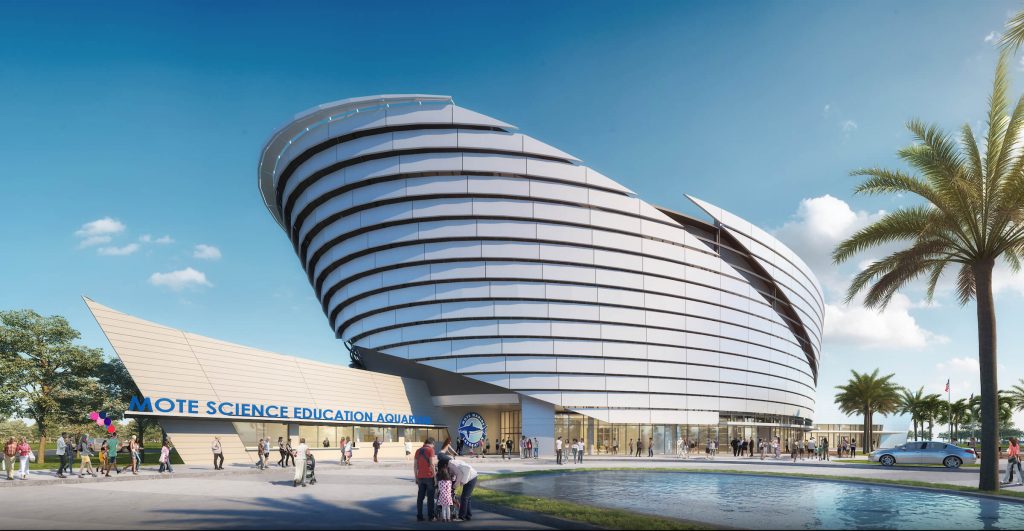
How did you choose the building shape, size and style as shown in renderings?
We sought a flowing artistic design evoking the region’s natural beauty, with inspiration from the ocean. Simultaneously, we carefully considered the practical and experiential needs of our visitors, resident animals and staff. We sought to concentrate staff operations and life support areas toward the bottom of the facility and allow for vast exhibit spaces and open teaching labs to accommodate many more visitors.
As shown in the preliminary renderings, Mote SEA will be an iconic building unique to Southwest Florida, where wonder and learning will begin, even before visitors step inside. The building’s unique design, rising into the sky like ripples on a calm sea, and outdoor features such as wetlands nature trails will stir curiosity, just as our oceans do.
What will be the economic impact of Mote SEA?
The two-year construction of Mote SEA is projected to benefit Florida’s economy by producing $280 million in direct and indirect expenditures and a total of 3,123 people employed over the construction period.
Beyond the one-time benefits of new construction, Mote SEA by itself—not including Mote’s research enterprise—will support more than 260 direct and indirect jobs, while providing approximately $28 million annually in economic benefits for the State of Florida.
How will the new Aquarium’s annual economic impact compare with that of the current Mote Aquarium on City Island?
The $28-million annual economic impact projected for the new Mote SEA represents a marked increase from the estimated $12-million annual economic impact estimated for the current Mote Aquarium.
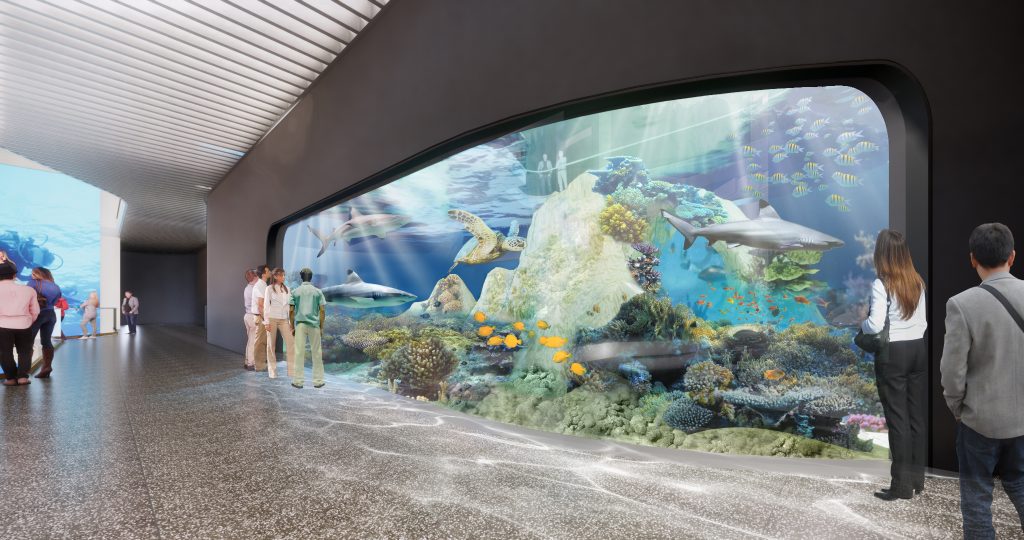
What are the key features of the Mote Science Education Aquarium, including expected exhibits? Will there be new animal species added?
The building will have more than 110,000 square feet of space, with exhibits totaling more than 1 million gallons of water and featuring a stunning array of sharks, coral reef species, manatees, sea turtles, otters, and myriad other wildlife. The current Mote Aquarium has more than 100 marine species and we seek to expand upon that; the exact species list is being determined. Visitors’ horizons will expand, with glimpses of the deep sea or other remote habitats, including Mote research sites from around the world.
Science will fill each moment of the visitor’s experience, with augmented reality technology creating an immersive ocean biome to explore. Interactive teaching labs will be accessible to schools in the region, including no-cost opportunities, so that each child has the chance to discover marine science and technology, first-hand. Strategically collaborating with schools and community groups where needs are the greatest, Mote will continue to educate children who might not otherwise have access to aquariums and marine science education.
Has the novel coronavirus and the disease it causes, COVID-19, affected the plan for Mote SEA?
Mote and its partners have continued to work diligently toward the creation of Mote SEA, while working just as diligently to upgrade the existing high levels of health-safety protection at the current Mote Aquarium. Through these efforts at our current Aquarium, we are gaining valuable experience that will be applied when the Aquarium is reborn as Mote SEA.
It is clear that our visitors value Mote’s high standards of health-safety protection, accommodations for social distancing and robust virtual learning opportunities. Each of these efforts informs our Mote SEA planning process—for example: our upcoming efforts to model visitor flow in the new building will examine social distancing variables; our plans for ticketing at Mote SEA have always included a focus on outdoor and online ticket sales—practices we have recently enhanced at the current Mote Aquarium to support distancing and touchless visits; and we are examining new technologies to support remote engagement with Mote SEA, which would expand our already significant virtual offerings (examples of current offerings are available at mote.org/virtual).
What will happen at Mote’s City Island campus, the original home of Mote Aquarium?
The rebirth of Mote Aquarium on the mainland will not only help us grow our informal science education and outreach programs and develop a more ocean-literate society; equally important, it will lead to the next step in the evolution of our City Island campus into an enhanced International Marine Science, Technology & Innovation Park with an additional 60,000 square feet of new, state-of-the-art research infrastructure. This will provide Mote researchers, science and technology entrepreneurs and their international partners much-needed facilities for expanded intensive research and allow Mote’s best and brightest to excel in addressing the significant threats facing Earth’s oceans.
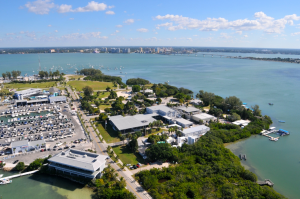
We expect that Mote Marine Laboratory will become the catalyst for a new “Silicon Valley” of marine science and technology in Southwest Florida, leading to more than just improved conservation and sustainable use of our oceans. The innovations and intellectual property generated by Mote and a growing marine science and technology sector will be the fuel for an expansion of Florida’s blue economy, with impacts felt well beyond our state.
Please note: The Oceans for All fundraising effort is specifically focused on creating Mote Science Education Aquarium, NOT on this distinct effort to advance research on Mote’s City Island campus.
If volunteers who serve the Aquarium on City Island and can’t make the drive to the new Mote SEA site at Nathan Benderson Park, will they have opportunities to stay involved with Mote?
Yes. Once the Aquarium is reborn at the new site, we expect to have a growing number of volunteer positions associated with our research operations of Mote Marine Laboratory, which will remain and advance on City Island. In addition, Mote’s City Island campus will include an expanded rescue and rehabilitation program for marine mammals and sea turtles, as well as some selected exhibits for the public to view. For volunteers who wish to serve at the City Island site and work with the public, we expect that there will also be opportunities to assist with education programs or tour groups that will continue to visit the site and learn more about the incredible research infrastructure that will be operating every day. And of course, volunteers will be needed and welcomed at the new Mote Science Education Aquarium. We’ll make sure our existing team of about 1,500 volunteers is the first to know about new and expanded opportunities to help out. Volunteers are, and will continue to be, the lifeblood of Mote.
How long will the current Mote Aquarium on City Island remain open?
City Island is home to Mote Marine Laboratory and its current public outreach facility, Mote Aquarium. After the Aquarium is reborn on the mainland, the Laboratory will stay on City Island and will advance its research efforts immensely, evolving to become an enhanced International Marine Science, Technology & Innovation Park.
The current Mote Aquarium on City Island will stay open until we complete construction of the new Mote Science Education Aquarium on mainland Sarasota County; contingent on our fundraising and construction progress, this is expected to be in 2023. At that time, the City Island Aquarium will close to allow the evolution and advancement of our scientific efforts on City Island. We expect there will be a period of time between the original Aquarium closing and the new one opening—which will allow us to ensure the health and well-being of our animals in their new home. We will be sure to give our community plenty of advance notice regarding this transition.
Meanwhile and thereafter, we will offer tours and education programs at the City Island campus, and the research taking place there will enhance and refresh the offerings at the new Mote SEA.
When Mote Aquarium is reborn on the mainland (as Mote SEA), will there be any change in the mission and animal care standards of the institution overall (Mote Marine Laboratory)?
Mote Marine Laboratory’s mission focuses on taking great care of our oceans through research, conservation and public education that encourages ocean stewardship, and through animal hospitals that rehabilitate dolphins, small whales and sea turtles. With the new Mote SEA on the mainland, and Mote Marine Laboratory’s research continuing and advancing at our new International Marine Science, Technology & Innovation Park on our City Island campus, we continue to maintain our unique culture as one of the few remaining independent marine research institutions with global impact. However, we will also be significantly expanding our ability to push the frontiers of science, with the sustainability of our ocean resources first in mind. We believe deeply that our public outreach must feature marine life in ways that benefit, rather than exploit, wild populations. Our current efforts include breeding and raising certain species–such as seahorses, jellyfish and fragments of Florida corals–to reduce pressures on wild populations, and providing homes for large marine animals deemed non-releasable by government institutions–such as our current resident sea turtles. While the new Mote SEA will expand our educational efforts on the mainland, our City Island campus will continue its efforts to rescue, rehabilitate and release large marine animals. Cetaceans (dolphins and whales) are among the animals we rescue, but they will not be featured at the new Mote SEA.
In sum, Mote’s mission is not changing–it is just growing in an effort to reach far more people from all walks of life. We’ll continue the mission that made us who we are today: a scientific institution that shares its knowledge through a homegrown, public Aquarium, with strong animal rescue and rehabilitation efforts and a major focus on education.
How will Mote transport salt water to the proposed new Aquarium site at Nathan Benderson Park?
We will have the option to transport salt water from the coast or to prepare it on-site using a commercially available formula added to fresh water. This is one of the many details we are working on. First and foremost, our goal is to do what is best for the health and well-being of our animals.
It should be noted that many other public aquariums are built in landlocked areas and not located near saltwater bodies. We will certainly review and utilize best practices from those aquariums accredited by the Association of Zoos and Aquariums (Mote is accredited), in producing or transporting salt water.
What access to public transportation is available at the proposed new site?
Our proposed site within Nathan Benderson Park is easily accessed from a bus stop for Sarasota County Area Transit (SCAT).
Will there be enough parking at the proposed new site for Mote Science Education Aquarium?
Future development around Nathan Benderson Park, as well as existing parking west of the proposed Mote site (accessible with a SCAT bus stop), will provide ample parking to the facility.
How will animals be acclimated to the new Aquarium facility, and how long will that take?
The process and time needed to acclimate will vary by species. In every case, our number-one goal is to do what is best for the health and well-being of each individual animal and species in our care.
Will Mote need more staff at the new Mote SEA?
Yes. The new Mote SEA will need a larger staff because it will serve a much greater cross section of residents and visitors. Mote SEA by itself—not including Mote’s research enterprise—will support over 260 direct and indirect jobs.
Will the new Mote Science Education Aquarium include Gulf of Mexico exhibits?
Of course! The Gulf of Mexico ecosystems in Mote’s “backyard” will always be an important part of our outreach, in addition to our research sites around the world.
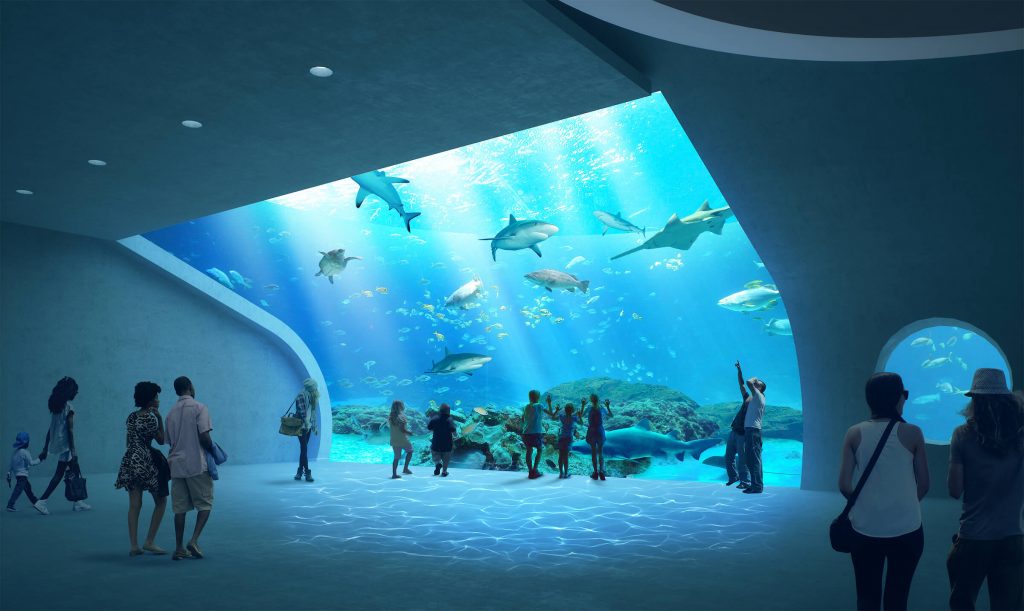
Will the walking paths or rowing areas at Nathan Benderson Park be affected by the placement of Mote SEA?
No. Our goal is to place Mote SEA along the causeway at the northern end of Nathan Benderson Park, where it will not affect rowing activities or public access to this popular community park. In fact, we hope that the presence of Mote SEA will enhance use of the park lands, as we aim to include wetlands nature trails and water play areas accessible to all.
Will the plans for Mote SEA affect the cost of my Mote Membership?
We will always aim to keep membership pricing within a reasonable range for families in this region, and it is not our goal to cover the costs of the new Mote SEA through membership fees. Rather, to realize our vision for this new facility and its goal—sharing ocean literacy with more people from all walks of life—we are proud to present our fundraising effort Oceans for All: Improving Access to Marine Science & Technology, which seeks support from three avenues: philanthropy, organization/corporate partnership and public support (local and state). Learn more about these efforts at the main page of this website, moteoceansforall.org.
We are grateful to all our members. The funds generated from Mote’s Membership program help support Mote’s resident Aquarium animals, educational outreach and world-class research.
